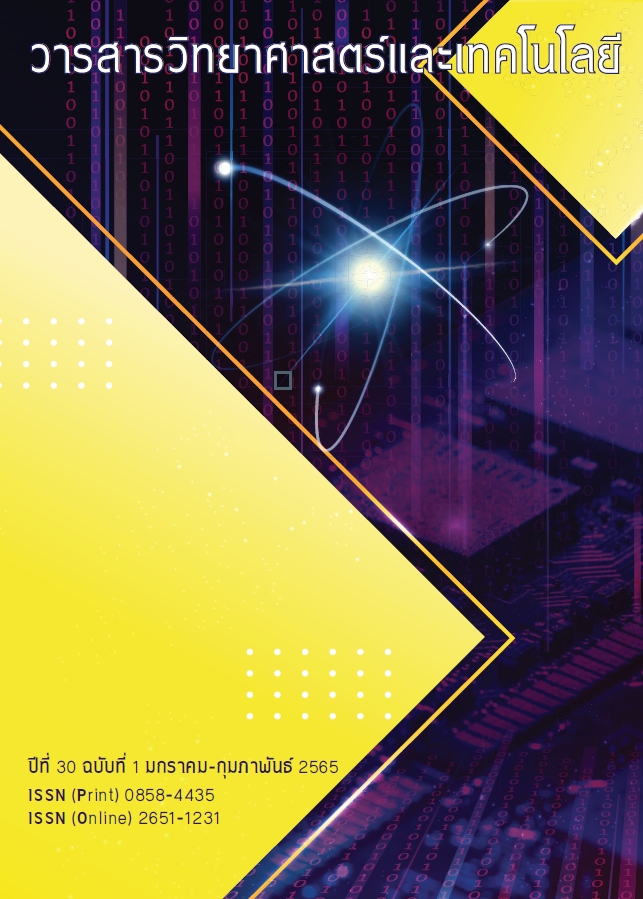The Effect of Ammonium Vanadate to Tamarind Fruit Aqueous Extract and PEG Mole Ratios on the Structure of W Doped VO2 Nanoparticles and Phase Transition Behavior
Main Article Content
Abstract
This work aims to study the effects of ammonium vanadate : aqueous extract from tamarindpulp (TA) : polyethylene glycol (PEG) mole ratios on the crystal shape, size, and structure of 2% atomic tungsten doping vanadium dioxide (W doped VO2) nanoparticles by using one-step hydrothermal method. The ammonium vanadate acts as the vanadium (+5) source. The TA and PEG act as the reducing agent and the particle distribution. The obtained products were characterized by Fourier transform infrared spectroscopy (FT-IR), X-ray diffraction (XRD), field emission scanning electron microscope (FE-SEM), energy dispersive X-ray spectroscopy (EDX), and differential scanning calorimetry (DSC). From the results showed that at the mole ratio of NH4VO3:TA:PEG 5:0.01:0.2, the mixed phases of VO2 (M) with VO2 (B) and VO2 (P) with 16 nm particle diameter of dark-blue spherical-like were crystallized. Meanwhile TA was increased at the mole ratios of NH4VO3:TA:PEG of 5:0.5:0.1, 5:1:0.1, 5:1.1:0.4, and 5:2.2:0.4, observed only VO2(B) and VO2(P) phases. DSC confirmed phase transition temperature (PTT) of VO2(M) → VO2(R) appeared at the range of 21-35°C and reversible phase of VO2(R) → VO2(M) at 36°C. In addition, observed PTT at 87°C due to mixed-phases of VO2(B) and VO2(P). Hence, the as-prepared W doped VO2 can be applied for well infrared smart films at ambient temperature.
Article Details
References
Chang, T.-C., Cao, X., Bao, S.-H., Ji, S.-D., Luo, H.-J. and Jin, P., 2018, Review on thermochromic vanadium dioxide based smart coatings: from lab to commercial application, Adv. Manuf. 6: 1-19 and reference therein.
Cui, Y., Ke, Y., Liu, C., Gao, Y., Chen, Z., Wang, N., Zhang, L., Zhou, Y., Wang, S., Gao, Y. and Long, Y., 2018, Review: thermochromic VO2 for energy-efficient smart windows, Joule 2: 1-40.
Hu, L., Tao, H.Z., Chen, G.H., Pan, R., Wan, M.N., Xiong, D.H., and Zhao, X.J., 2016, Porous W-doped VO2 films with simultaneously enhanced visible transparency and thermochromic properties, J. Sol-Gel Sci. Techn. 7(1): 85-93.
Liang, S., Shi, Q., Zhu, H., Peng, B. and Huang, W., 2016, One-step hydrothermal synthesis of W-Doped VO2 (M) nanorods with a tunable phase-transition temperature for infrared smart windows, ACS Omega 1: 1139-1148.
Chaipornpokin, W. (2008). Quantitative analysis of organic acids in aqueous extracts of Tamarindus Indica pulp and preparation of tamarind powders, Master Thesis (M.Sc.), Chulalongkorn University, Bangkok, 112 p.
Tucureanu, V., Matei, A. and Avram, A. M., 2016, FTIR spectroscopy for carbon family study, Crit. Rev. Anal. Chem. 46(6):502-520.
Tsegay, Z. T., 2020, Total titratable acidity and organic acids of wines produced from cactus pear (Opuntiaficus-indica) fruit and Lantana camara (L. Camara) fruit blended fermentation process employed response surface optimization, Food Sci Nutr. 8(8): 4449-4462.
Au–pree, S., Narakaew, P., Thungprasert, S., Promanan, T., Chaisena, A. and Narakaew, S., 2021, Enhanced photocatalytic activity of C-doped TiO2 under visible light irradiation: a comparison of corn starch, honey, and polyethylene glycol as a carbon sources, Eng. J. 25(1): 53-68.
Peng, Z., Ji, C., Zhou, Y., Zhao, T. and Leblanc, R. M., 2020, Polyethylene glycol (PEG) derived carbon dots: preparation and applications, Appl.Mater. Today 20 (100677): 1-16.
Bera, M., Yadav, C., Gupta, P. and Maji, P. K., 2018, Facile one-pot synthesis of graphene oxide by sonication assisted mechanochemical approach and its surface chemistry, J. Nanosci. Nanotechnol.18(2) : 902-912.
Xu, Y., Huang, W., Shi, Q., Zhang, Y., Wu, J. and Song, L., 2013, Shape-dependent thermochromic phenomenon in porous nanostructured VO2 films, Mater. Res. Bull. 48: 4146-4149.
Li, M., Magdassi, S., Gao, Y. and Long, Y., 2017, Hydrothermal synthesis of VO2 polymorphs: advantages, challenges and prospects for the application of energy efficient smart windows, Small: 1701147.
Zou, J., Peng, Y. and Lin, H., 2013, A low-temperature synthesis of monoclinic VO2 in an atmosphere of air, J. Mater. Chem. A 2013 (1): 4250-4254.
Zhang, Y., 2016, VO2 (B) conversion to VO2 (A) and VO2 (M) and their oxidation resistance and optical switching properties, Mater. Sci.-Poland 34(1): 169-176.
Wu, C., Feng, F., Feng, J., Dai, J., Yang, J. and Xie, Y., 2011, Ultrafast solid-state transformation pathway from newphased goethite VOOH to paramontroseite VO2 to rutile VO2 (R), J. Phys. Chem. 115(3): 791-799.


